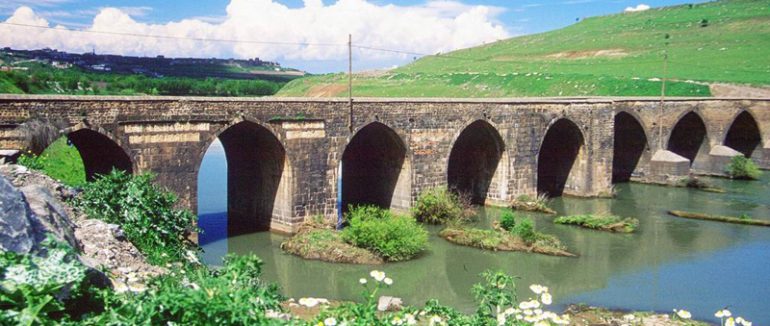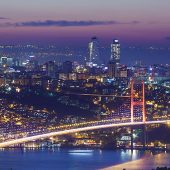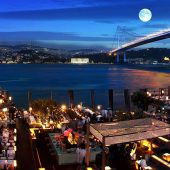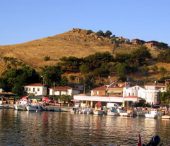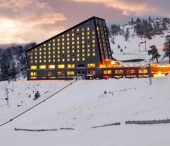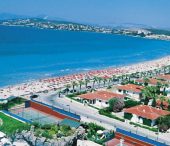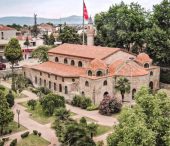Diyarbakır is a major city in the Southeast of the Republic of Turkey. Situated on the banks of the River Tigris, it is the seat of Diyarbakır Province, and has a population of 545,000. It is the second largest city in Turkey's South-eastern Anatolia region, after Gaziantep. Within Turkey, Diyarbakır is famed for its culture, folklore, and watermelons. Diyarbakır has a large Kurdish population, and is sometimes referred to as the "unofficial capital" of the regions ethnic Kurds
Etymology
According to some scholars, the modern name "Diyarbakır" derives from "Diyârbekir", an Ottoman Turkish Language rendering of the Persian compound "Diyâr-i Bekr" ("Land of the Bekr"), itself composed of the word "diyār" (ديار), which is Arabic for either "region" or "district", followed by " Bekr " (بکر), it probably denoted the landholdings of the Arab Bekr tribe (which had settled in the area following the Islamic conquest of the 7th Century).
In an analysis by the Kurdish scholar Mehrdad Izady of the Department of Near Eastern Languages and Civilizations at Harvard University, the name Bakir is derived from the toponym Bagraoandene and is related to the Bagrawands or Bakrans tribal Kurdish names. At various times the previous name Amid was written as Amida, and Kara Amid.
History
Antiquity
Amid(a) was the capital of the Aramean kingdom Bet-Zamani from the 13th century B.C. onwards. Amid is the name used in the Syriac sources, which also testifies to the fact that it once was the seat of the Church of the East Patriarch and thus an Assyrian or Syriac stronghold that produced many famous Syriac theologians and Patriarchs; some of them found their final resting place in the St. Mary Church. There are many relics in the Church, such as the bones of the apostle Thomas and St. Jacob of Sarug (d. 521)
The city was called Amida when the region was under the rule of the Roman (from 66 BC) and the succeeding Byzantine Empires.
From 189 BC to 384, the area to the east and south of present-day Diyarbakır, was ruled by a Kurdish kingdom known as Corduene.
In 359, Shapur II of Persia captured Amida after a siege of seventy-three days. The Roman soldiers and a large part of the population of the town were massacred by the Persians. The heroic siege is vividly described by Roman historian Ammianus Marcellinus who was an eyewitness of the event and survived the massacre by escaping from the town.
Armenian historians at one time hypothesized that Diyarbekir was the site of the ancient Armenian city of Tigranakert, (pronounced Dikranagerd in the Western Armenian dialect) and by the 19th century the Armenian inhabitants were referring to the city as Dikranagerd. Scholarly research has shown that while the ancient Armenian city was in the close vicinity, it in fact is not the same place. The real location of Dikranagerd remains debated, but Armenians who trace their ancestry to Diyarbekir continue to refer to themselves as "Dikranagerdtsi" (native of Dikranagerd.) The "Dikranagerdtsi's" or Armenians of Diyarbekir were noted for having one of the most unusual dialects of Armenian, hard to understand for a speaker of standard Armenian.
The Middle Ages
In 639 the city was captured by the Arab armies of Islam and it remained in Arab hands until the Kurdish dynasty of Marwanid ruled the area during the 10th and 11th centuries. After the Battle of Manzikert in 1085, the city came under the rule of the Mardin branch of Oghuz Turks and then the Anatolian Turkish Beylik of Artuklu (circa 1100-1250 in effective terms, although almost a century longer nominally). The whole area was then disputed between the Ilkhanate Turks and Ayyubid Kurdish dynasties for a century after which it was taken over by the rising Turkmen states of Kara Koyunlu (the Black Sheep) first and Ak Koyunlu (the White Sheep).
The Ottoman Empire
The city became part of the Ottoman Empire during Sultan Süleyman I's campaign of Irakeyn (the two Iraqs, e.g. Arabian and Persian) in 1534. The Ottoman eyalet of Diyarbekir corresponded to Turkey's southeastern provinces today, a rectangular area between the Lake Urmia to Palu and from the southern shores of Lake Van to Cizre and the beginnings of the Syrian desert, although its borders saw some changes over time. The city was an important military base for controlling this area and at the same time a thriving city noted for its craftsmen, producing glass and metalwork. For example the doors of Mevlana's tomb in Konya were made in Diyarbakır, as were the gold and silver decorated doors of the tomb of Imam-i Azam in Baghdad.
In the 19th century, Diyarbakır prison had gained infamy throughout the Ottoman Empire as a site where political prisoners from the enslaved Balkan ethnicities were sent to serve harsh sentences for speaking or fighting for national freedom.
The 20th century
The 20th century was a turbulent one for Diyarbakır. During World War I most of the city's Syriac and Armenian population was driven from the city. After the surrender of the Ottoman Empire, French troops attempted to occupy the city.
The 41-year-old American-Turkish Pirinçlik Air Force Base near Diyarbakir, known as NATO's frontier post for monitoring the former Soviet Union and the Middle East, completely closed on 30 September 1997. This return was the result of the general drawdown of US bases in Europe and improvement in space surveillance technology. The base near the southeastern city of Diyarbakir housed sensitive electronic intelligence-gathering systems that kept an ear on the Middle East, Caucasus and Russia.
Diyarbakır today
During the recent conflict, the population of the city grew dramatically as villagers from remote areas where fighting was serious left or were forced to leave for the relative security of the city. Rural to urban movement has often been the first step in a migratory pattern that has taken large numbers of Kurds from the east to the west. Diyarbakır, grew from 30,000 in the 1930s to 65,000 by 1956, to 140,000 by 1970, to 400,000 by 1990, and eventually swelled to about 1.5 million by 1997. Today the intricate warren of alleyways and old-fashioned tenement blocks which makes up the old city within and around the walls contrasts dramatically with the sprawling suburbs of modern apartment blocks and cheaply-built gecekondu slums to the west.
After the PKK's cessation of hostilities, a large degree of normality returned to the city, with the Turkish government declaring a 15 year period of emergency rule over on 30 November 2002. The local economy is slowly improving. There is however a lot more that needs to be done, and in August 2005 mayor Osman Baydemir presented the Turkish Prime Minister Tayyip Erdoğan with the following complaints:
A grant of 500,000 euros from the German Development Fund KFW to redign the city's waste disposal system was refused by the State Planning Authority (DPT) of the Turkish government in Ankara, and then a 22 million project to renew the system was also prevented.
A grant of 350,000 euros for the rehabilitation of the Tigris valley, from the Turco-Spanish Economic and Financial Union, was declared unnecessary by the DPT in 2005.
A dentistry project jointly agreed with and funded by South Korea and EAID (the Eurasian Institute of Dentistry) had to abandoned after the dentists were refused work permits.
A five million euro project to build a tram system in the city was abandoned after the Turkish government refused to guarantee a 15-year loan from Deutsche Bank that the city had negotiated.
In the urban renewal project for 2005 presented to the EU commission 10 million euros were granted to Diyarbakır. However the State Planning Authority (DPT)of the Turkish government reallocated 4 million of this to other cities (Gaziantep, Şanlıurfa and Erzurum), who failing to present projects lost this money.
In another instance a 30 million euro loan from the EU was prevented by the DPT
According to a November 2006 survey by the Sur Municipality, one of Diyarbakır's metropolitan municipalities, 72% of the inhabitants of the municipality use Kurdish the most in their daily speech, followed by Turkish, and 69% are illiterate in their most widely used vernacular.
Arts and culture
Some jewelry making and other craftwork continues today although the high fame of the Diyarbakır's craftsmen has long gone. Folk dancing to the drum and zurna (pipe) are a part of weddings and celebrations in the area.
Cuisine
Diyarbakır is known for rich dishes of lamb (and lamb's liver, kidneys etc.); spices such as black pepper, sumac and coriander; rice, bulgur and butter.
Places of interest
The city walls - Diyarbakır is surrounded by an intact, dramatic set of high walls of black basalt forming a 5.5 km (3.4 mi) circle around the old city. There are four gates into the old city and 82 watch-towers on the walls, which were built in antiquity, restored and extended by the Roman emperor Constantine in 349.
Places of worship - Diyarbakır boasts numerous medieval mosques and madrassahs including:
Ulu Camii ("Great Mosque") built by the Seljuk Turkish Sultan Malik Shah in the 11th century. The mosque, one of the oldest in Turkey, is constructed in alternating bands of black basalt and white limestone. (The same patterning is used in the 16th century Deliler Han Madrassah, which is now a hotel. The adjoining Mesudiye Medresesi was built at the same time as was another prayer-school in the city Zinciriye Medresesi.
Hazreti Süleyman Camii - 1155-1169 - Süleyman son of Halid Bin Velid, who died capturing the city from the Arabs, is buried herealong with his companions.
Safa Camii - built in 1532 by the Ak Koyunlu Turkmen tribe.
Nebii Camii - another Ak Koyunlu mosque, a single-domed stone construction from the 16th century. Nebi Camii means "the mosque of the prophet" and is so-named because of the number of inscriptions in honour of the prophet on its minaret.
Dört Ayaklı Minare (the four-footed minaret) - built by Kasim Khan of the Akkoyunlu, it is said that one who passes seven times between the four columns will have his wishes granted.
Fatihpaşa Camii - built in 1520 by Diyarbakır's first Ottoman governor, Bıyıklı Mehmet Paşa ("the moustachioed Mehmet pasha"). The city's earliest Ottoman building it is decorated with fine tilework.
Hüsrevpaşa Camii - the mosque of the second Ottoman governor, 1512-1528, originally the building was intended to be a school (medrese)
İskender Paşa Camii - and another mosque of an Ottoman governor, an attractive building in black and white stone, built in 1551.
Beharampaşa Camii - an Ottoman mosque built in 1572 by the governor of Diyarbakır, Behram Pasha, noted for the well-constructed arches at the entrance.
Melek Ahmet Camii another 16th century mosque, noted for its tiled prayer-niche, and the double stairway up the minaret.
The Syriac Orthodox church of Our Lady (Syriac: ܐ ܕܝܠܕܬ ܐܠܗܐ`Idto d-Yoldat Aloho, Turkish: Meryemana kilisesi), was first constructed as a pagan temple in the 1st century BCE. The current construction dates back to the 3rd century, has been restored many times, and is still in use as a place of worship today. There are a number of other churches in the city.
Museums -
The Archaeological Museum contains artefacts from the neolithic period, through the Old bronze age, Assyrian, Urartu, Roman, Byzantine, Artuklu, Seljuk Turk, Ak Koyunlu, and Ottoman Empire periods.
Cahit Sıtkı Tarancı Museum - the home of the late poet is a classic example of a traditional Diyarbakır home.
The birthplace of poet Ziya Gökalp has been preserved as a museum to his life and works.

